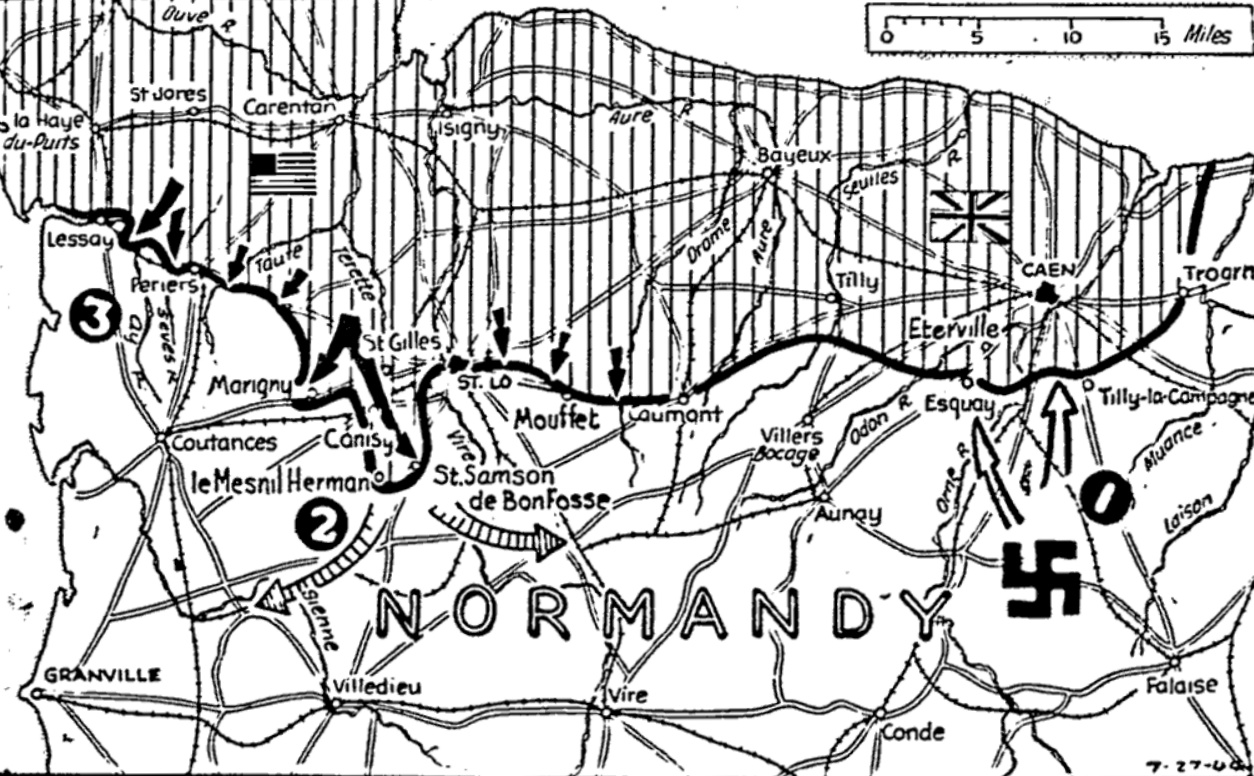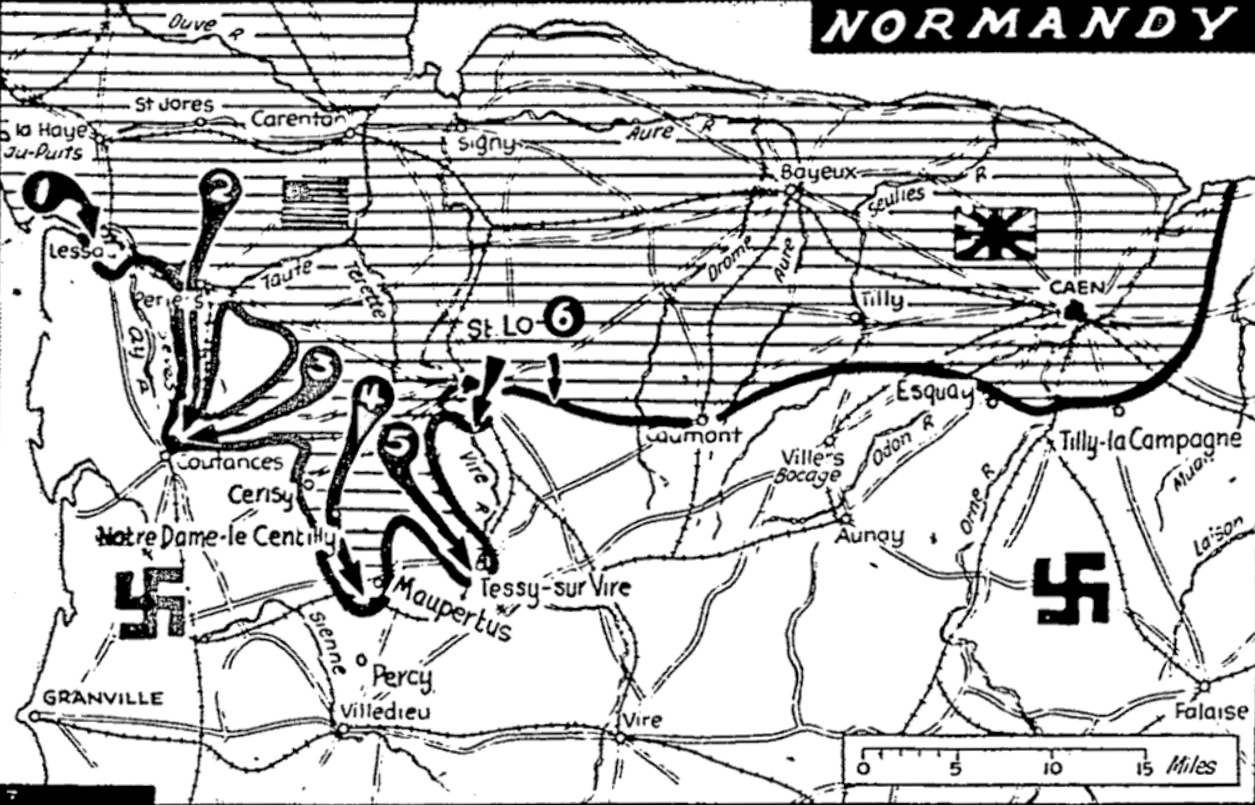The Pittsburgh Press (July 27, 1944)
Yanks drive seven more miles
U.S. column racing toward sea to trap seven German divisions
By Virgil Pinkley, United Press staff writer
Yank drive of seven miles into Nazi defenses for a total thrust of 12 miles in three days highlights news from France. The British were forced back in the Caen sector, withdrawing from Esquay and Tilly-la-Campagne (1). The Yanks captured Canisy and drove to Le Mesnil-Herman (2). Other U.S. forces thrust into Périers (3).
Bulletin
SHAEF, London, England –
The German defense line in Normandy cracked wide open today and a U.S. armored column raced southwestward toward the sea in a fast-breaking bid to shear off the Nazi left wing and trap the enemy’s 84th Army Corps of seven badly mauled divisions.
SHAEF, London, England –
U.S. armored columns raced forward up to seven miles today in their Normandy breakthrough drive, fanning out on a broad arc which overran the road junctions of Canisy and Le Mesnil-Herman and reached points 4¼ miles from Coutances and six miles south of Saint-Lô.
Field dispatches reported the capture of fire-ravaged Canisy, three miles southeast of Marigny, and said Lt. Gen. Omar N. Bradley’s tanks had spurted another five miles in the same direction to seize Le Mesnil-Herman on the Saint-Lô–Percy highway and reach Saint-Samson-de-Bonfossé.
The whirlwind advances through groggy German defenses expanded the breakthrough by U.S. armor to a depth of nearly 12 miles in less than three days of fighting. They also set the stage for flanking pushes to the east and west which, if successful, would collapse the whole southern rim of the German arc around the Normandy beachhead.
The main spearheads of the breakthrough forces were swinging southeastward below Saint-Lô and southwestward toward Coutances, the capture of which would undermine the Atlantic coastal wing of the German Army.
The German line between the Saint-Lô gap and the Atlantic was buckling under the U.S. 1st Army’s blows. U.S. patrols thrust into Périers, central hinge of the German defenses fronting Gen. Bradley’s troops, and the Lessay–Périers highway was cut in a gain of more than a mile.
The Nazi plight was reflected in a DNB News Agency estimate that Gen. Sir Bernard L. Montgomery can now send into the field “about 50 divisions, including very strong fresh tank formations.”
Gen. Bradley’s men generally were on the move from just west of Caumont to the sea, and were consolidating their armored gains as fast as infantry and artillery could be moved up.
Henry T. Gorrell, United Press writer who witnessed the breakthrough in its crucial phase yesterday, reported in a dispatch filed at 3:30 p.m. (local time) that by afternoon the foremost elements of the U.S. armor were at Saint-Samson-de-Bonfossé.
From another sector, United Press writer James McGlincy reported the capture of Le Mesnil-Herman, one of the biggest road hubs south of Saint-Lô.
The first field dispatches of the day reported the capture of Canisy. They said it burned all night after being set afire by the explosions which cracked German resistance.
Littered with Nazi dead
Mr. Gorrell reported:
A driver of a tank outfit said there was not much left of Canisy. The streets are littered with German dead, cut down by automatic weapons fired from halftracks as the Americans passed through. There was a brief street fight, which cost the Americans only a few casualties.
As the tank columns fanned out far beyond Marigny, dispatches reported that in some sectors Adolf Hitler’s famous SS regiments had pulled out and left the rearguard fighting to Polish conscripts, hundreds of whom were captured.
The weather had cleared, and wave upon wave of fighter-bombers battered all day at the German positions.
Mr. Gorrell reported:
As I write this, our fighter-bombers are returning from the front and executing victory rolls en masse. It is quite a sight to see as many as 40 of them do it simultaneously.
Eyewitnesses told Mr. Gorrell they had seen many German tanks knocked out along the Saint-Gilles–Canisy road. Big German Tiger tanks were battling U.S. Shermans in the advanced areas.
Terrific cannonade
The chief German resistance had been from mortars. Our infantry was fast cleaning up the corridors laid out by the tanks, and “such was the state of German demoralization at the sight of the U.S. armor that very few snipers stuck around,” Mr. Gorrell said.
Since yesterday afternoon, there has been a terrific cannonade as our mobile guns, supported by hundreds of other cannon in the rear, picked off observed targets. Our Piper Cubs now are flying over by dozens, spotting for the artillery.
Roads in the path of the advance are strewn with knocked-out German vehicles and German bodies. Our engineers are keeping pace with the advance, filling in the bomb and shell craters.
The east end of the American line was also rolling up slow but steady gains. Infantry reached Mouffet, five miles west of Caumont, in a two-mile advance from Montrabot. They took Bérigny and on the Saint-Lô–Caumont highway and pushed forward to the vicinity of Notre-Dame-d’Elle, three miles south of Bérigny and six miles east of Saint-Lô.
Farther to the east, the British and Canadians were forced to yield some ground both south and southwest of Caen in the face of increasingly heavy enemy counterattacks.
The British and Canadians withdrew completely from Tilly-la-Campagne, four and a half miles southeast of Caen, and also abandoned Esquay, six and a half miles southwest of Caen, and nearby Hill 112 on the bank of the Orne River. Both the Exchange Telegraph Agency and the London Daily Sketch said the withdrawals constituted a “serious setback” for Lt. Gen. Miles C. Dempsey’s 2nd Army.
Planes hit three ships
Allied fighter-bombers continued to give close support to the ground forces last night and boosted their toll for the day to 20 enemy tanks destroyed, 19 probably destroyed and 58 damaged. Fourteen gun positions were hit.
Planes also hit the three ship unloading supplies at Granville, 15 miles south of Coutances, as well as railway yards, fuel dumps, bridges and road junctions behind the battle line.
Front dispatches said the British and Canadians were regrouping south and southwest of Caen after their offensive push down the highway toward Falaise broke down in the face of strenuous opposition and counterattacks by four German panzer divisions.
Rocket-firing RAF Typhoons stopped one German counterattack yesterday evening before its infantry and supporting ranks could reach forward Canadian positions. Five tanks were destroyed and eight others damaged.

